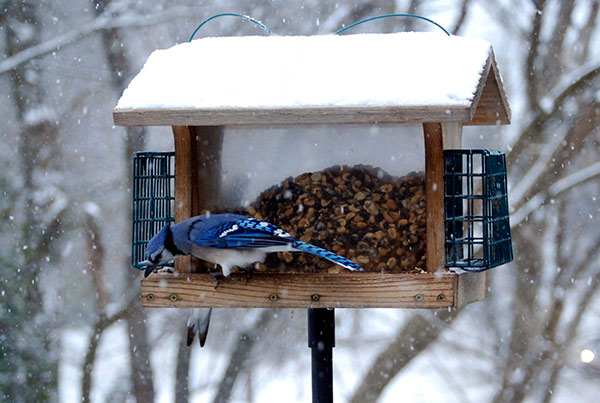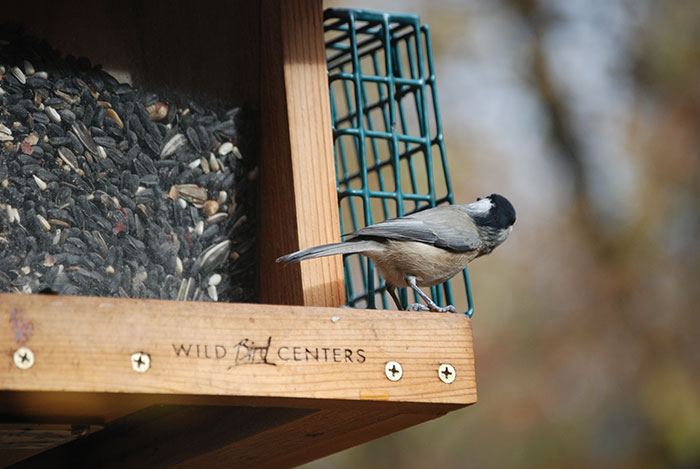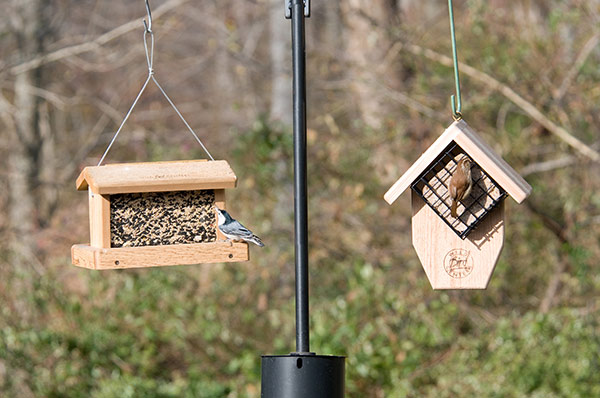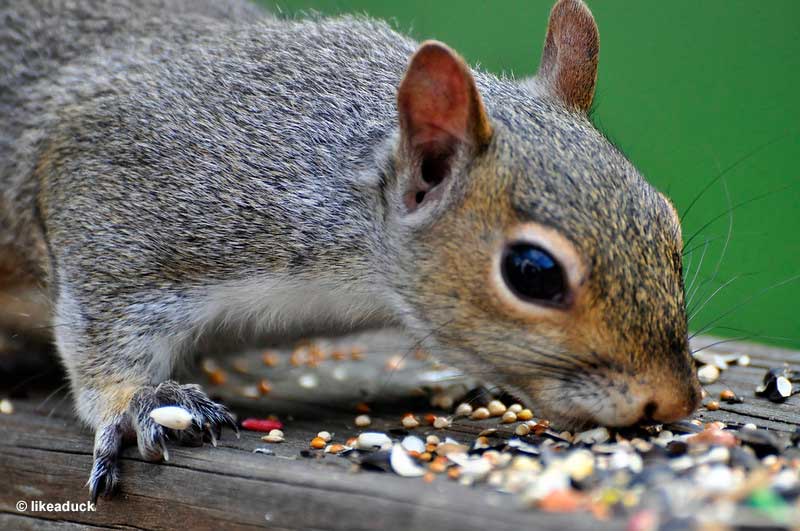
Feeding birds is truly one of the joys of life! Looking in the backyard and seeing cardinals, goldfinches, woodpeckers, and other beautiful birds always puts a smile on my face. It also lowers stress and makes me feel extra ready for the day.
I love feeding birds, but once in a while, they just aren’t there. When that happens, I check a few things, make some changes, and they eventually come back.
Why do birds stop coming to feeders? How can we keep birds coming to our feeders?
See this article for answers and more about why birds suddenly stop visiting a feeder and what you can do to bring them back.
On this page
Bound To Feeders
Birds love feeders for a simple reason; it’s an easy place to find food! It’s far easier for a Northern Cardinal to go somewhere with an abundance of black sunflower seeds.
If Blue Jays can fly to a feeder and pick up one peanut after another, they certainly take advantage of that special, reliable food source!
The same goes for chickadees, nuthatches, woodpeckers, and other types of birds that come to feeders. Why “shop” elsewhere when you can get so much food with little effort?

Species that eat seeds and other high-energy food tend to like feeders the most, especially in fall and winter. Chickadees and other common feeder birds also visit feeders during warmer seasons but not nearly as much as in the winter.
Related: Guide to bird seeds
In spring and summer, those birds are too busy eating bugs and raising young to visit feeders as much as in the winter. However, when the weather gets cold, Northern Cardinals and other birds naturally switch to eating berries and seeds, including the ones at our feeders.
You can still maintain feeders in spring and summer. However, you might want to put out less food and need to be extra careful about keeping the feeders clean.
Why Birds Don’t Come to Feeders
Birds occasionally stop coming to feeders, even in the winter. The following are some of the most common reasons why birds stop visiting feeders and what you can do to bring them back.
Predators!
Cardinals, nuthatches, and other favorite feeder visitors aren’t the only birds on the block. Predators are out there too! They are an essential part of nature and at some point, they are going to discover your feeders.
To thwart domestic cats, in addition to keeping them indoors, we can also place a motion activated sprinkler, or vinegar, pepper, and citrus beneath the feeder.
There are also avian predators that catch small birds. In the winter, Sharp-shinned Hawks often stalk feeders and Cooper’s Hawks can attack doves and other medium-sized birds all year long. On occasion, a rare Northern Shrike can also show up!
If these raptors appear, all you can really do is make sure the feeder birds have dense bushes where they can hide and feel safe.
The Feeders aren’t Full
This might sound like an odd problem, but it happens more than you think. We can forget to fill feeders, or a large number of birds might suddenly descend on a feeder and clean it out. If we go away for a few days, the birds might also eat all of the food.

A filled feeder keeps the birds happy!
Obviously, birds will leave a feeder that lacks food. However, they can also stop visiting feeders that are just unreliable. For example, if goldfinches find food only once out of every three or four visits, they might decide to forage elsewhere.
Even if you fix the problem and keep the feeder full for several days, it could take the birds a while to rediscover your feeding station.
Your Feeders are in a Bad Place
If birds stop visiting, your feeders might just be in a bad spot. If few birds were visiting in the first place, this could be the problem.
Fortunately, it’s a pretty easy one to solve.
Is the feeder way out in the middle of the yard? Is it under the bright sun and far from bushes and trees?
If you answer “yes” to either of those questions, your feeder is not in a good spot for birds. It might be a nice spot to watch or take pictures but birds won’t like it. When birds are feeding, they are also vulnerable and need to feel safe.
Move the feeder closer to bushes and trees and the birds should come back.
The Birds Don’t Like Your Feeder Food
Another simple problem might be poor feeder food. Birds can be picky eaters, but those careful feeding habits are necessary. If a bird eats poor-quality seed, it won’t get enough energy and nutrition and can become sick and die.

It’s why we don’t feed bread to ducks and also why many small birds avoid red and golden millet, milo, and rapeseed. These types of seeds are often used in birdseed as filler, especially cheap brands.
Related: The diet of birds – everything they eat
Better foods for backyard birds include black sunflower seeds, peanuts, and safflower seeds. Nyjer seeds are also great but make sure they are fresh. Goldfinches will pass up old, dry Nyjer seeds for a better, more energy rich food source.
The same goes for suet. Make sure it hasn’t become rancid!
Your Feeders Need Cleaning
If your regular birds are present but fly elsewhere, they might know something you don’t. Those birds may have come to the feeder but noticed old and rotten bits of food.
They might have felt that the overall feeder situation was just too dirty. A chickadee might have picked up a few seeds but then dropped them because they didn’t taste good.
You have to be very careful about maintaining clean and healthy feeders. If not, not only will fewer birds arrive, they can also catch and spread diseases!
To avoid harming backyard birds by mistake, give your feeders a thorough cleaning at least one a week. Use hot water and a bottle brush, and make sure to clean out any old and excess bird food.
Other Food is Available
You have squeaky clean feeders filled with the best in black sunflower and peanuts. The feeders are out of reach of cats and squirrels but close enough to bushes that birds can fly to.
It’s a bird-feeding paradise, and yet, there are no birds! What gives? If you find yourself presented with such a situation, don’t blame yourself (or the birds). They probably just have lots of other food available.
In the summer, in all likelihood ”your” Blue Jays, cardinals, and chickadees are busy eating insects. They are just using a better temporary food source but will probably be back in the fall.
If it’s fall or winter, the birds might just have too many other neighborhood feeders to choose from.
Read more: Winter bird facts & myths
Squirrels!
Feeder birds don’t get along with squirrels. In fact, they are afraid of them and with good reason. Squirrels sometimes attack bird nests and, when hungry enough, can even eat adult birds!
If given a chance, the arboreal rodents can also take over a feeder setup. Squirrels know a good feeding situation when they find one. Instead of taking a few seeds, they’ll sit right at the feeder and munch on peanuts and seeds for hours!

The mammals will happily devour your bird food and small birds won’t bother to return. To keep those squirrels at bay, use special squirrel-proof feeders and feeder poles with baffles. You should also place feeders at least ten feet from any spot a squirrel can jump from.
Lack of Water
Yet another factor that can convince birds to go elsewhere is the lack of water. While backyard birds are coming to feeders to eat, they also need water. They need it to drink as well as to bathe.
Both regular feeder birds and non-feeder beauties like warblers, vireos, and flycatchers love to splash in shallow water. If there are backyards nearby with feeders, ponds, or bird fountains, you can bet that’s where the birds are going!
Related: Starter’s guide to birdbaths
A water feature is especially important in hot weather. During extreme heat, birds might not even bother visiting a backyard that doesn’t have water. They may need to bathe so they can stay cool and simply survive!


Brad Abernethy
Friday 8th of March 2024
I noticed in the first photo the feed used was mixed seed. We never use this as much of it is trash seed. We use sunflower seed in a large feeder, Niger seed in a tube feeder and suet in a suet block feeder. Never, ever do we have any difficulty with birds visiting. The three types of feed we have provide the needs of at least thirty types of birds in our area. Keep away from mixed seed. Too much of it is filler that birds don't eat.